
unit04
.pdf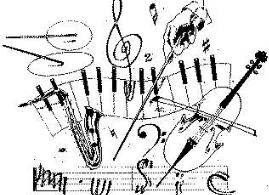
Unit 4. At the rehersal
Victor: Let's start with some practicing exersises . |
|
Тренировочных упражнений |
|
||
Andy: I'm sick and tired of all those scales and arpeg- |
|
тошнит, от гамм и |
gios. |
|
арпеджио |
Victor: We all do not have perfect pitch and only diffi- |
|
абсолютный слух |
culties in reading music let alone sight -reading. And |
|
не говоря уже о |
you, Andy often misses entrances. |
|
пропускает вступления |
Rosy: But your sense of rhythm, Victor, especially for |
|
чувство ритма |
anything syncopated, is virtually non-existent, and |
|
синкопировано |
exercises won't help. |
|
|
Victor: And you , Rosy, are playing the piano out of |
|
не в тон (не по тем нотам); |
tune. I'm sure you are not looking at the music and |
|
в ноты |
playing flat. Then you mixing up bass cleffs and treb- |
|
"без знаков" |
ble cleffs, touching wrong notes ... |
|
"цепляя" неверные ноты |
Jane: Stop argueing, everybody. I think that any |
|
|
group should avoid any quarells. They bring only |
|
|
harm. Nobody is pefect. I remember a well-known |
|
|
conductor. He had much trouble at music school. His |
|
|
hands couldn't span a full octave on the piano, so he |
|
дотянуться |
was not striking the keys by the the finger recom- |
|
"брать" ноту нужным |
mended and that, paticularly on the black notes, the |
|
пальцем; |
little finger was falling short of expectations. He was |
|
не доставал |
thinking of changing instruments - going back to the |
|
|
woodwind class, where he was biting through oboe |
|
|
reeds at the sessions, or the strings department, |
|
трости |
where he was dropping the viola bow, or the percus- |
|
смычок |
sion wing, where he was snapping drumsticks, or the |
|
ронять |
brass class, where he was trying to swallow a trumpet |
|
|
mouthpiece. He was making such a pig's ear out of |
|
мундштук; испохабить (make |
one of the most beautiful melodies Brahms ever com- |
|
a mess) |
posed. Now it's hard to get tickets to his concerts and |
|
|
recitals, as a soloist or accompanying guest singers |
|
концерты для солиста |
and instrumentalists. |
|
|
Andy: You are right, Jane. |
|
|
|
|
|
Say if the statement is right or wrong |
right |
wrong |
Andy enjoys scales and arpeggios.
Victor has perfect pitch and good sight -reading.
Quarells bring only harm.
Andy used to snap drumsticks.
Continuous (progressive) -
действие находится в развитии в определенный момент времени
He is writing a song now. Are/Is + V + ing
He was writing a song at 5 o'clock yesterday.
Was/Were + V + ing
PRESENT PROGRESSIVE образуется при помощи вспомогательного глагола to be, который изменяется по лицам и числам + четвёртая форма глагола (4 ф.гл. =
1ф.гл. +ing). I - am
He, she, it - is + 4ая форма глагола. You, they, we - are
Настоящее продолженное время происходит в момент речи, то есть в данный
момент, действие, о котором идёт речь, может больше и не повториться. eg. What are you doing? - I am playing the accordion.
Ввопросительных предложениях (только общий вопрос, требующий ответа ДА или НЕТ) на первое место ставится изменённый по лицам и числам
вспомогательный глагол to be, затем подлежащее (может быть выражено либо
существительным, либо местоимением), сказуемое (глагол) и второстепенные члены предложения.
Вотрицательных предложениях добавляется частица not.
Существует большая разница между НАСТОЯЩИМ ПРОСТЫМ и НАСТОЯЩИМ
ПРОДОЛЖЕННЫМ ВРЕМЕНЕМ, при переводе не путайте, пожалуйста, например:
Я хожу и Я иду. |
|
|
Present Progressive не употребляется с глаголами: |
|
|
To love - любить, |
to believe - верить, |
to see - видеть |
To like - нравиться, |
to wish - желать, |
to hear - слышать |
To forget - забывать, |
to remember - помнить |
|
To hate - ненавидеть, |
to need - нуждаться |
|
To know - знать , |
to understand - понимать |
|
To want - хотеть, |
to be - быть - находиться |
|
Вместо этого глаголы употребляются в Present Simple.
Use the verbs in brackets in Present Continuous:
What … you (do)?
She … (read) notes.
They … (not stand) on the stage.
I … (play) a serenade.
Whose account … you (work) on?
She … (study) hard for her final exam.
We … (have) a gig this evening.
What … you (do) tomorrow afternoon?
She … (come) on Friday.
Common present continuous time expressions include: at the moment, now, today, this week, this month, tomorrow, next week (for future arrangements ), currently
|
am I |
|
|
|
|
|
are you |
|
|
is he |
|
What |
is she |
doing this afternoon? |
|
is it are we |
|
|
are you |
|
|
are they |
|
Choose the correct variant:
-Where are your children?
-They … 1) on the carpet and … 2).
1)lie; are lying; lies; 2) are listening to music; listen; listens.
Listen! Somebody ….. a nice song. sings, is singing, are singing
-What … you …1) now?
-I ... 2) for my key. I can't open the door.
1)are doing; do …. do; is … doing 2) look; am looking; is looking.
Why … you changing the melody? The music fits the words perfectly. don't; doesn't; do, are.
Don't make so much noise. I … to work. is trying; try; am trying; are trying
At the moment we … people. entertain, are entertaining
Present Simple or Present Progressive:
1.We (perform) pieces of music on musical instruments every morning.
2.What … this word (mean)?
3.At this moment we (do) an exercise on transposition.
4.… you (know) that boy over there?
5."What … you (do), Tom?" "I (harmonize)." "Let me see what … you (harmonize)."
6.… you (see) anything?
7.I (not remember) his name exactly.
8.Grandpa (be) by himself in the library. Grandpa (do) the orchestration.
9.I (hope) you (know) where he (live).
10."… you (read), dear?" "Yes." "What (be) the book about?" "Don't talk to him while he (read)."
11.You (play) too loudly, so of course you (get) deaf.
12.How long … it (take) you to get to the Institute, usually?
13.… you (like) what you (do) now?
14."It (snow) now?" "Yes, it (snow) very hard. You can't go out yet."
15.What … you (want)?
16."Hello!" said Freddie. "What … you (do) here?"
17."You (wear) a new coat?" "Yes, you (like) it?" "The colour (suit) you but it (not fit) you very well. It (be) much too big."
18.Mr. Black often (go) to the theatre but his sister (not go) very often. He (like) all sorts of plays. She (prefer) comedies.
19."Why … that man (stand) in the middle of the stage?" "He … (try) to concentrate. ".
20."Why … he (not use) an accompanist ?" "Some people (not bother) to use an accompanist. They (risk) singing solo."
Случаи употребления THE PAST PROGRESSIVE TENSE
1. Для обозначения действий, протекавших в точно указанный момент в
прошлом.
Этот момент может быть выражен:
a) точным указанием времени, когда происходило действие:
I was writing a letter to my friend at 6 p.m. yesterday. - Я писал письмо моему другу вчера в 6 часов вечера.
б) придаточным предложением:
Jane was talking about Robin when Liz came in.- Джейн говорила о Робине, когда вошла Лиз.
2. PAST PROGRESSIVE употребляется по тем же правилам, что и PRESENT PROGRESSIVE:
а) для выражения действий в прошлом, которые происходили не только в точно
указанный
момент, но и более широкий отрезок времени:
He said he was playing a new piece.- Он сказал, что играет новую пьесу.
( действие происходило в более широкий отрезок времени, но являлось главным для говорящего).
б) для выражения запланированного действия в будущем, когда вступает в силу
правило
согласования времен:
Ann said she was meeting Andrew on Monday. - Анна сказала, что встречается
сЭндрю в понедельник.
3.Past Progressive не употребляется с глаголами, которые нельзя использовать в группе Progressive, вместо этого глаголы употребляются в Past Simple.
To love - любить, |
to believe - верить, |
to see - видеть |
To like - нравиться, |
to wish - желать, |
to hear - слышать |
To forget - забывать, |
to remember - помнить |
|
To hate - ненавидеть, |
to need - нуждаться |
|
To know - знать , |
to understand - понимать |
|
To want - хотеть, |
to be - быть, находиться |
|
Look at - смотреть на … Listen to - слушать |
можно употреблять в Past |
|
Progressive. |
|
|
While they were talking she was listening to him very attentively.
Обратите внимание!
а) Действия, выраженные глаголами в главном и придаточном предложениях, не равны
по длительностиодно длилось дольше, чем другое. Действие, которое длилось дольше,
следует выражать глаголом в Past Progressive, а действие, которое длилось более
короткий период времени, следует выражать глаголом в Past Simple.
Маша писала ( длилось дольше) письмо, когда вошел (длилось короче) в комнату
её отец.
Masha was writing (Past Progressive) a letter when her father entered (Past Simple) the room.
б) Когда действия главного и придаточного предложений следуют друг за другом,
то глаголы главного и придаточного предложений употребляются в Past Simple.
Когда она вошла в комнату, он выключил телевизор.
(Действия, выраженные глаголами вошла и выключил, следуют друг за другом.) - When she entered the room he turned TV off.
Past Simple or Past Progressive
Example: I was working upstairs when the accident happened. (work, happen)
He … book and … to read. (open, start)
We … the music, when suddenly the electricity … off. (enjoy, go)
Everyone … quietly. Suddenly they ... noise. (talk, hear)
When I … the doorbell, I ... downstairs. (hear, run)
The conductor … the contract when the manager … . (check, call)
When she … the news, she ... to cry. (hear, begin) The students … a test when the bell ... . (write, ring)

Conducting
Conducting is more than waving your arms in front of the band. The conductor has two primary responsibilities:
To start the ensemble, to establish a clear, uniform tempo, and keep it throughout the performance.
To help the musical quality of the piece (expression, dynamics, cues).
There are many different conducting styles. The starting position is important .
Your upper arms should be away from your body. They should be slightly in front. Your forearms should be parallel to the ground. Your palms should show a little bit and your fingers should be up.
Your upper arms should be slightly away from your sides, elbows out, but not too far. (If you feel like you are doing the little birdie dance, you are out too far). Your hands should come in and should line up with your arm pits.
Conducting a down beat:
The solid line is the down beat.
The dotted line is the rebound.
Moving your arms from the shoulder, bring your hands straight up, so that your wrists are at about eye level. All of the palms of your hands should show. Your elbow should not change position much, if at all. This is the preparation position to conduct the down beat. To conduct the down beat simply bring your hands back to the starting position. Quickly flick your fingers down to hit the focal point. This little flicking motion determines the actual beat.
5 rules for conducting
1:All beats are down beats.
2:All beats strike the focal point.
3:All beats rebound.
4:All rebounds are equal in all ways to the down beat
5:The size of the rebound depends on the speed of the music.
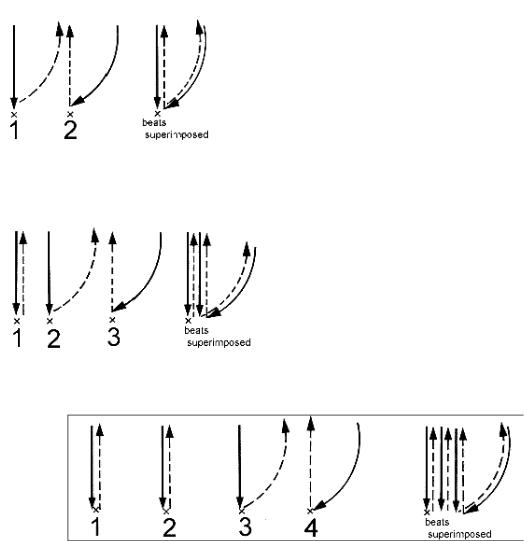
A good conductor is mindful of the rebound. If the rebound is too large, the conductor must rush to get back to the focal point. If the rebound is too small, the conductor may be forced to pause to get back in tempo, confusing the beat and the musicians.
Rebounds, and thus downbeats, determine the speed of the music. Smaller downbeats are used for faster music, larger downbeats are used for slower music. The reason for this is because in fast music you don't have time to move your hands too far, and in slow music you do. To try otherwise is a waste of energy.
When conducting a two pattern, conduct the down beat but instead of coming straight back up, veer to the side. Beat two brings the hands back to the focal point and then straight up again.
The Three pattern, also known as 'Down-out- up' is a combination of the two pattern and the one pattern. The first beat is a one pattern, which goes down and rebounds staright up.
The second beat goes out, similar to the beginning of the two pattern. The third beat finishes the two pattern.
The four pattern is one of the most commonly used patterns. When learning the pattern, say to yourself 'down-down-out-up'. This patterns follows the same trend as previous ones. The four is the same as the three pattern but the four has an extra down at the beginning.
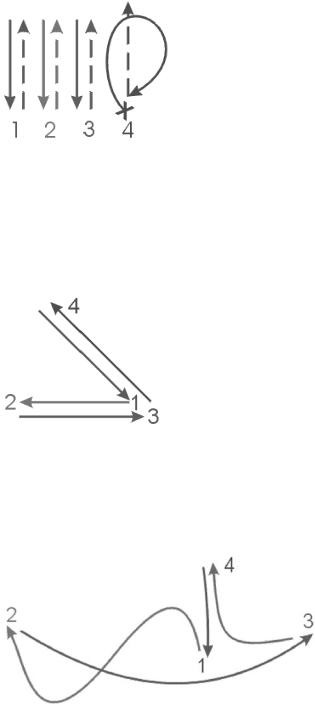
This is the 'down-down-reverse-around' pattern. The first two beats are simple downbeats, but the third beat rebounds in a circle towards the outside. The circle continues around until beat four. At beat four, give a flick of the wrist at the focal point (your hand should be there) and rebound up.
This pattern has a weak fourth beat. It is very useful in conducting the last half note on the last two beats of a measure. This patterns is good for building up to a new phrase or as part of a dynamic change. This pattern is generally not used over and over, but instead only as needed.
The 'Thump' pattern is good for very fast music. The first beat comes to the focal point at an angle. The second beat slides in on a plane with the focal point. The third beat slides back across the focal plane to where the first beat ended. The fourth beat retraces the first beat back up. The pattern doesn't rebound, but still accentuates all the beats, hitting the first beat especially strongly (freeze on beat 1 for a moment).
This pattern is mostly wrist movement (because of the fast speed). Because your hands go in, watch out that your arms stay apart (or your hands will run together and mess up the tempo).
This is another four pattern. This is larger pattern, one good for moderate and slow music. Beat one comes down and, instead of rebounding up, goes across the chest, curving up (think 'over a hill' ) and down (think 'into a valley') then hangs bit at beat two. The right hand then slides in a long curve into beat three which is out, away from the body on the other side of the conductor. Beat four slides in and up to prepare for beat one.
DO NOT MIRROR HANDS, at least for the entire pattern. (Crossing hands is a no-no.)
If you want to use the left hand, only use it for beats three and four. After beat four drop the left hand to your side or stomach to leave room for the right hand, which will shortly be crossing your body.
This is a pattern good for more formal groups, orchestras, choirs, and symphonic bands. This pattern can be used in marching band for, say, a ballad.
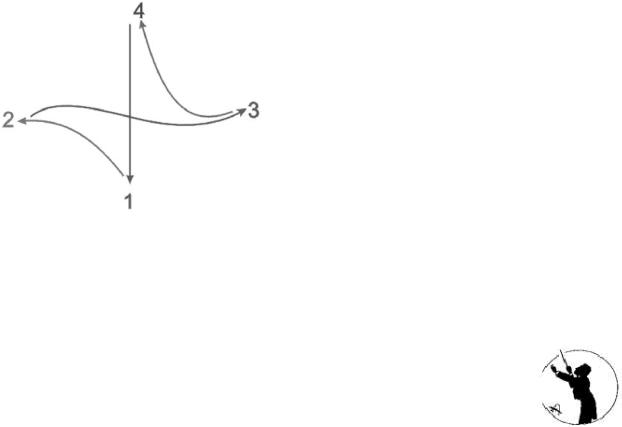
The legato pattern is another four pattern. It is good for legato music with soaring phrases.
When conducting this expressive pattern use only the right hand (don't mirror). The pattern is similar to the above pattern in that it crosses the body for beat two and extends away from the body on beat three.
The wrist is much more relaxed for this pattern. From beats two to three the wrist leads, 'pulling' the pattern out. The wrist leads again from three to four, 'pulling' the pattern up.
The size of the pattern is fairly large since most legato music has a slow or moderate tempo.
A marching band conductor would most likely never use this pattern on the field. This is another pattern which is suited better for symphonic bands, vocal groups and orchestras.
Humour
A Player's Guide for Keeping Conductors in Line (by Donn Laurence Mills)
If there were a basic training manual for orchestra players, it might include ways to practice not only music, but one-upmanship. It seems as if many
young players take pride in getting the conductor's goat. The following rules are intended as a guide to the development of habits that will irritate the conductor. (Variations and additional methods depend upon the imagination and skill of the player.)
1.Never be satisfied with the tuning note. Fussing about the pitch takes attention away from the podium and puts it on you, where it belongs.
2.When raising the music stand, be sure the top comes off and spills the music on the floor.
3.Complain about the temperature of the rehearsal room, the lighting, crowded space, or a draft. It's best to do this when the conductor is under pressure.
4.Look the other way just before cues.
5.Never have the proper mute, a spare set of strings, or extra reeds. Percussion players must never have all their equipment.
6.Ask for a re-audition or seating change. Ask often. Give the impression you're about to quit. Let the conductor know you're there as a personal favor.
7.Pluck the strings as if you are checking tuning at every opportunity, especially when the conductor is giving instructions. Brass players: drop mutes. Percussionists have a wide variety of dropable items, but cymbals are unquestionably the best because they roll around for several seconds.
8.Loudly blow water from the keys during pauses (Horn, oboe and clarinet players are trained to do this from birth).
9.Long after a passage has gone by, ask the conductor if your C# was in tune. This is especially effective if you had no C# or were not playing at the time. (If he catches you, pretend to be correcting a note in your part.)
10.At dramatic moments in the music (while the conductor is emoting) be busy mark-
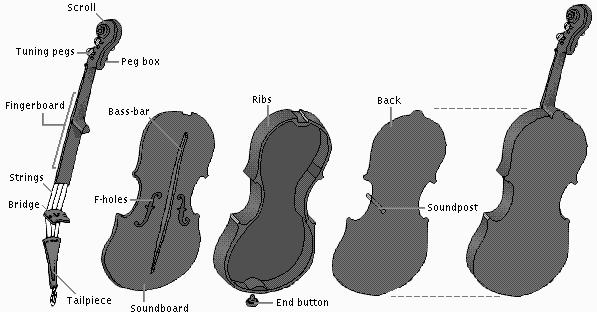
ing your music so that the climaxes will sound empty and disappointing.
11.Wait until well into a rehearsal before letting the conductor know you don't have the music.
12.Look at your watch frequently. Shake it in disbelief occasionally.
13.Tell the conductor, "I can't find the beat." Conductors are always sensitive about their "stick technique", so challenge it frequently.
14.Ask the conductor if he has listened to the Bernstein recording of the piece. Imply that he could learn a thing or two from it. Also good: ask "Is this the first time you've conducted this piece?"
15.When rehearsing a difficult passage, screw up your face and shake your head indicating that you'll never be able to play it. Don't say anything: make him wonder.
16.If your articulation differs from that of others playing the same phrase, stick to your guns. Do not ask the conductor which is correct until backstage just before the concert.
17.Find an excuse to leave rehearsal about 15 minutes early so that others will become restless and start to pack up and fidget.
18.During applause, smile weakly or show no expression at all. Better yet, nonchalantly put away your instrument. Make the conductor feel he is keeping you from doing something really important.
It is time that players reminded their conductors of the facts of life: just who do conductors think they are, anyway?
(Donn Laurence Mills is the NSOA contributing editor. He holds music degrees from Northwestern University and Eastman School of Music. A conductor and music educator, he is also the American educational director for the Yamaha Foundation of Tokyo.)
What else do you need to play the violin?
Find the English for:
подставка, обечайка, струны, дека, дужка, колки, гриф, колковый механизм
